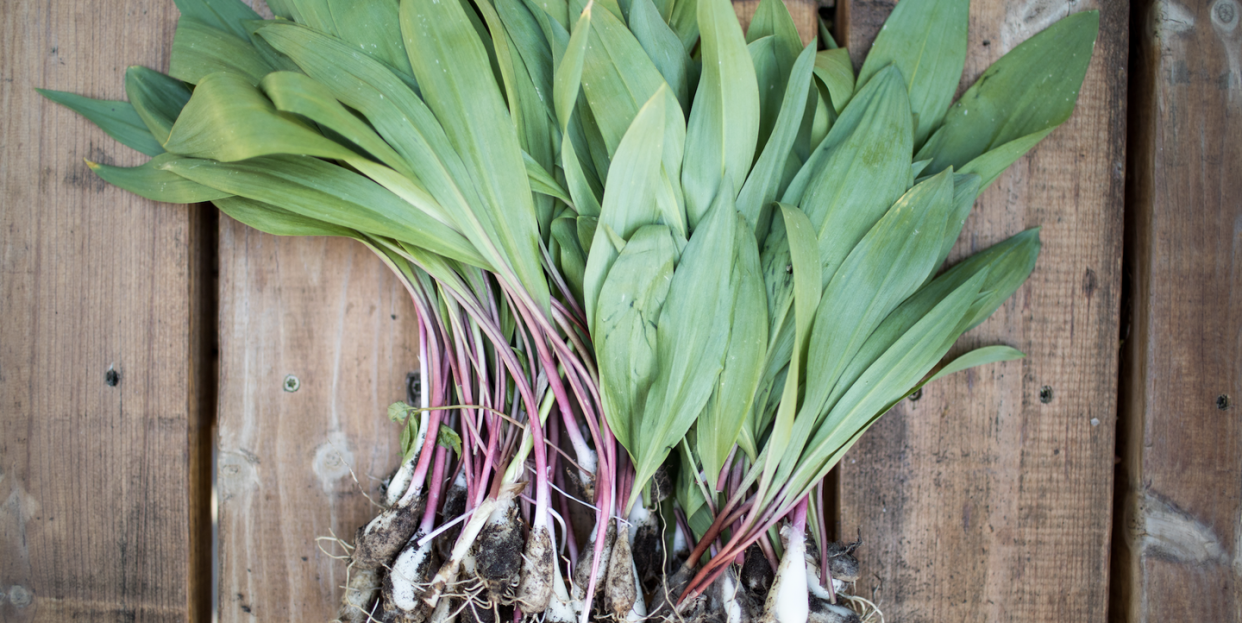It's Ramp Season, and You're Not the Only Person Who Has No Clue What They Are

Ferocious-smelling, heavenly-tasting ramps (the foods, not the highway structures) are a sure sign of early spring, especially in the Northeast. In springtime, they start to appear on forest floors, in farmers’ markets, and, if you’re lucky, perhaps even in your local supermarket. They're so popular in parts of the country that there are ramp festivals, including one held for the past 80-plus years in North Carolina, complete with a ramp-eating contest and a King and Queen of Ramps. These greens can be enjoyed raw (if you dare!), sautéed, roasted or even pickled. Treat them as a flavoring in your favorite vegetarian frittata or wilt the leaves to add to an easy weeknight stir-fry.
What are ramps, exactly?
Also known as wild onions or wild leeks, these fragrant members of the allium family are related to garlic and scallions, too.
What do wild ramps taste like?
Peppery and powerful raw, like a cross between garlic, scallion, and onion, they mellow with cooking. If you like your food aromatic with a bit of a (garlicky) kick, you’ll love ramps. Their pungent aroma and flavor make them a natural pairing with foods like potatoes and eggs, and if you’re not afraid of a peppery bite, wait ‘til you try ramp pesto in a steaming bowl of pasta or slathered over a veggie-filled pizza. They’re fantastic grilled and served alongside a juicy steak (maybe topped with some of that ramp pesto again!)
What part of ramps do you eat?
The plants consist of 2, sometimes 3, broad smooth leaves each on their own stem, a reddish pink stalk and a slender luminous white root end that sometimes forms a slight bulb. Other than the roots and the translucent covering around the bottom part of the stem, you can eat every part of the ramp. Trim off the roots, if attached, and peel off and discard the thin protective sheath around the base and wash thoroughly. Treat the bottom white and light pink part as you would garlic or onion. The leaves can be sautéed until just wilted or tossed in a food processor with some softened butter to make a flavorful topping for just about anything.
How do you store ramps?
Ramps are best eaten as soon as possible, but they can be stored, unwashed, in the refrigerator for four days or so. The leaves wilt more quickly than the stalks and will last only a day or two, especially if detached from the rest of the plant. For longer-term storage, the root ends can be pickled (fabulous in tacos or sandwiches) or made into ramp butter (see above) and frozen for a month or two if well-wrapped.
Where do wild ramps grow?
Ramps can be found in the eastern half of the U.S., primarily the Northeast, with a concentration in Appalachia. The plants grow in the woods, often on slopes and beside streams, and they are one of the first spring crops to appear. Their popularity may be enhanced by their scarcity, since their season lasts only 3 (at most 4) weeks in mid to late April up to early May, depending on the weather.
Any buying tips?
Before buying, ask your purveyor how they were obtained. These wild native plants should be sustainably harvested by digging small clumps out of large patches (some say no more than 10%), leaving enough to grow into new patches for future feasts. (A good rule to follow if you’re lucky enough to forage for them in person.) To be safe, some people cut off just above the roots.
If you see full plants for sale, roots included, and you aren’t convinced whether they were harvested sustainably, don’t buy them. Some markets sell just the leaves, and they’re a guilt-free way to get into the gloriously garlicky ramp game.
You Might Also Like

